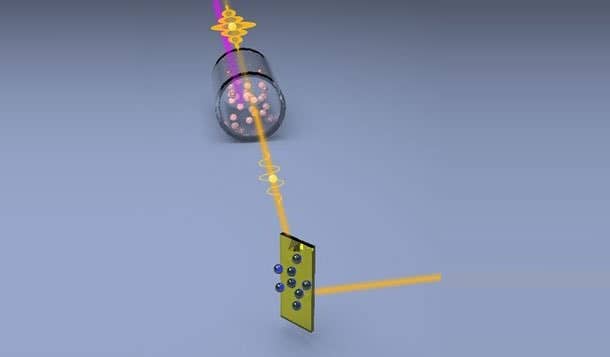Scientists use quantum entangled light to improve microscope sensitivity by 50%
Scientists use quantum entangled light for a new form of microscopy able to detect signals normally hidden by quantum noise.

[Feb 14, 2022: Michael Church, DOE/US Department of Energy]
A quantum light approach for microscopy enables scientists to measure signals with much-improved sensitivity. (CREDIT: Oak Ridge National Laboratory)
The Science
Lasers are often used to look at objects in microscopes. But even the best laser has “quantum noise” that makes a picture blurry and hides the details. This in turn results in measurements that are less precise than scientists need. Researchers have designed a new type of microscope that uses squeezed light to reduce measurement uncertainty. Unlike today’s classical microscopes, this quantum microscope requires quantum theory to describe its sensitivity. The microscope uses special “nonlinear” amplifiers to generate a quantum light source known as squeezed light. This approach enabled a 50 percent improvement in the sensitivity of a specific scientific measurement.
The Impact
Scientists routinely use devices called atomic force microscopes to measure the properties of materials at the nanoscale. This novel method reduced the degree of uncertainty in atomic force microscopy. This will result in new understanding of the properties of materials. With enough squeezing, this approach can unveil fast electronic interactions that cannot be measured with a classical microscope. In addition, the squeezed light heats the microscope much less than a laser would.
This is particularly important for microscopes operated at very low temperatures or for materials that are sensitive to changes in temperature. Microscopes with reduced uncertainty, higher speeds, and lower temperatures will open the door to new studies of quantum materials and quantum devices.
Related Stories
Summary
Quantum microscopy relies on extremely delicate control of light waves. However, its sensitivity is typically limited by optical losses. In this research, scientists circumvented the problem with a special type of entangled light called “squeezed light.” In this case, squeezing means that the intensities of the light beams are correlated with each other at the quantum level. Because of this, noise in the measurements is reduced, thus providing a higher signal to noise ratio.
The research performed here integrated an atomic force microscope microcantilever into a low-loss nonlinear interferometer that generated squeezing with a four-wave mixing process. The researchers reduced measurement uncertainty with minimal heating of the cantilever by taking advantage of low-power squeezed light and high-power reference signals (the latter never interact with the microcantilever).
By increasing the power in the reference signals and increasing the squeezing at the same time, it is now possible to achieve a substantial improvement in microscope sensitivity.
Funding
This research was supported by the Department of Energy Office of Science, Basic Energy Sciences, Materials Sciences and Engineering Division. The experimental concept was conceived, and initial experiments were performed as part of the Laboratory-Directed Research and Development Program of Oak Ridge National Laboratory. Several of the researchers were supported by the Department of Energy Office of Science, Office of Workforce Development for Teachers and Scientists under the Science Undergraduate Laboratory Internship program. One researcher was supported by the W.M. Keck Foundation.
For more science and technology news stories check out our New Innovations section at The Brighter Side of News.
Note: Materials provided above by DOE/US Department of Energy. Content may be edited for style and length.
Like these kind of feel good stories? Get the Brighter Side of News' newsletter.
Tags: #New_Innovations, #Microscopes, #Quantum, #Light, #Lasers, #Atoms, #Research, #Science, #The_Brighter_Side_of_News
Joseph Shavit
Head Science News Writer | Communicating Innovation & Discovery
Based in Los Angeles, Joseph Shavit is an accomplished science journalist, head science news writer and co-founder at The Brighter Side of News, where he translates cutting-edge discoveries into compelling stories for a broad audience. With a strong background spanning science, business, product management, media leadership, and entrepreneurship, Joseph brings a unique perspective to science communication. His expertise allows him to uncover the intersection of technological advancements and market potential, shedding light on how groundbreaking research evolves into transformative products and industries.



